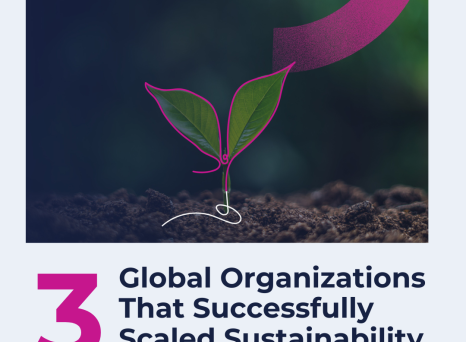Drones delivering cargo. Robot workers in warehouses. Virtual reality simulations of extreme weather or political events. To the average person, these things might seem like novelties or publicity stunts.
Drones delivering cargo. Robot workers in warehouses. Virtual reality simulations of extreme weather or political events. To the average person, these things might seem like novelties or publicity stunts. But, they don't appear that way to future-minded supply chain managers. To them, these technologies are the answer to the question: “How can we transform our operations and prioritize sustainability?”
Supply chains have had to adapt to unprecedented disruptions in the last decade. This follows events such as Brexit, the COVID-19 pandemic, and the Russia-Ukraine war. You might assume that organizations are now well-prepared to react quickly to upheaval. But, recent research found that 83% of supply chains still can’t respond to disruptions in 24 hours.
Despite this prevailing issue, there's good news. Increased agility, resilience, and environmental, social, and governance (ESG) ratings are all possible with new technologies. Here are four innovations that every supply chain leader should consider for their digital transformation.
Radio-Frequency Identification (RFID)
Radio-frequency identification (RFID) technology is already fascinating shoppers at self-service checkouts across the world. Instead of scanning barcodes, customers drop their items into the fixed basket next to the till-point. The RFID-enhanced till system automatically identifies each item and calculates the total spend. All you need to make this happen are RFID tags embedded in the items (or their labels) and a nearby RFID scanner.
How does this translate to supply chain transformation for greater resilience and sustainability? Let’s break it down:
- More accurate inventory. With RFID-tagged products, companies can get exact stock levels, no matter how widely it’s distributed. Having access to this data in real-time reduces the risk of overstocking or overproduction. This minimizes product wastage, which lessens environmental impact and unnecessary costs.
- Greater visibility of materials and manufacturing. It can be a struggle for organizations with large, complex supply chains to maintain visibility of N-tier suppliers. This can create gaps in crucial ESG data, but it can also conceal inefficiencies. Fitting products with RFID tags early in the manufacturing process simplifies things. It allows companies to track products' physical journeys at scanning ‘checkpoints.’
- Tracking the full product lifecycle. There are data privacy risks in RFID. But, if regulators and responsible organizations can resolve them, it unlocks benefits for both sustainability and commerciality. For example, companies could identify how long their products are being used before disposal. They could also track where and how customers are disposing of them. This, in turn, highlights opportunities to improve product lines. Or to create targeted recycling programs to reduce waste.
Robotics
Have you spotted any drone deliveries in your area? They’re gaining momentum as an alternative to fossil-fueled vehicles for last-mile delivery. But, behind the scenes, their robotic cousins are also contributing to a greener, more resilient supply chain.
Warehouse robotics are becoming increasingly sophisticated, with Amazon as a clear leader in the space. Its autonomous robots Proteus and Digit make processes like warehouse organization and order packing more efficient and safer for human workers.
Robotics can also extend the capacity of existing warehouse spaces. And that's without increasing physical or carbon footprint. Warehouse managers can stack inventory higher and more compactly. This is because they don’t have to worry about the impracticality or health and safety (H&S) risks for human workers. Robots also don’t need the same temperatures or visibility as humans to work effectively and safely. So, companies can reduce emissions and save costs on heating and lighting in robot-staffed sections of warehouses.
Maximizing inventory space and reducing energy use also improves a location's return on investment (ROI). This unlocks faster scaling and more streamlined logistics. That's because companies can expand warehouse operations into smaller, more central hubs in existing urban buildings. In turn, this improves customer experience without compromising worker safety or green space.
Artificial Intelligence and Machine Learning (AI/ML)
No list of innovative technologies would be complete without artificial intelligence and machine learning (AI/ML). They’re already key differentiators for supply chain organizations. Gartner has reported that companies automating or optimizing their decisions with AI/ML are more likely to be 'high-performers'. This means they exceed expectations in their supply chain outcomes.
With access to relevant, high-quality data, AI/ML can accelerate or even automate key processes throughout the supply chain. The same Gartner report found that high-performers were more likely than low-performers to be using AI/ML to optimize decisions in order management and fulfillment (33% vs. 8%). But, high-performers are also using the technology to drive the performance of their demand forecasting (40% vs. 19%) and supply planning (31% vs. 12%).
It might sound like you need a supercomputer to realize these benefits. But, there are already software companies using AI/ML to power up their enterprise products. Using historical project and supply chain data, PPM software with AI/ML capabilities can make faster, more accurate predictions about the success of products in the pipeline and their production requirements. This helps to increase the ROI of new products and reduces waste from excess raw materials and components or overproduction.
With the right PPM provider, supply chain leaders can benefit from:
- Automated forecasting. By analyzing historical data, predictive analytics that use ML algorithms can more accurately forecast budgets, resource utilization, workloads and more.
- AI-enhanced supply planning. With AI-driven Particle Swarm Optimization (PSO), supply chain leaders can intelligently balance their resources to avoid shortfall or waste.
- Higher quality data. Anomaly detection features can automatically flag potential data issues, leading to more reliable data for process optimization and ESG reporting.
Digital Twins
Imagine being able to stress test your supply chain without any risk. Thanks to digital twin technology, what was once a pipe dream is now a reality. A digital twin is a complete replica of your supply chain in a digital environment. To create one, organizations need to have access to real-time, connected data sources throughout their supply chain. This ensures that the digital twin stays accurate and relevant for supply chain decision-making.
Supply chain leaders can then use predictive machine learning algorithms to simulate the effects of different scenarios. This helps understand the potential impact on their supply chain. These scenarios include:
- Changing suppliers or transport routes
- How rolling out new products will affect materials, production, and logistics
- Introducing process improvements
- The impact of climate change and geopolitical unrest in certain regions
Organizations need additional technologies to enable a digital twin of their supply chain. Sensors distributed throughout the actual supply chain gather real-time data. But, digital twins also require advanced analytics, simulation, and visualization capabilities.
This requires a significant financial investment. But, it empowers companies to answer their “What if?” scenarios faster and with greater accuracy. It also reveals opportunities to reduce environmental impact. Consumer electronics manufacturers have used digital twins to reduce scrap by roughly 20%. With digital twin technology, teams can:
- Improve their supply chain’s sustainability
- Adapt more quickly to supply chain disruptions
- Avoid revenue loss through more agile, data-driven decision-making.
Driving sustainability with data
These technologies represent a promising new frontier for sustainability in the supply chain. But, how can supply chain leaders identify the right technologies for their organizations and optimize their function? With access to the right high-quality data and powerful analytics. These capabilities allow greater visibility of your supply chain activity and faster, more accurate insight generation. Using this knowledge, you can better assess where certain technologies could improve sustainability in your supply chain. One technology that combines these capabilities is PPM software. It can aggregate and analyze all of your supply chain data in one place, often with AI/ML-powered features for even more efficient supply chain management workflows.


